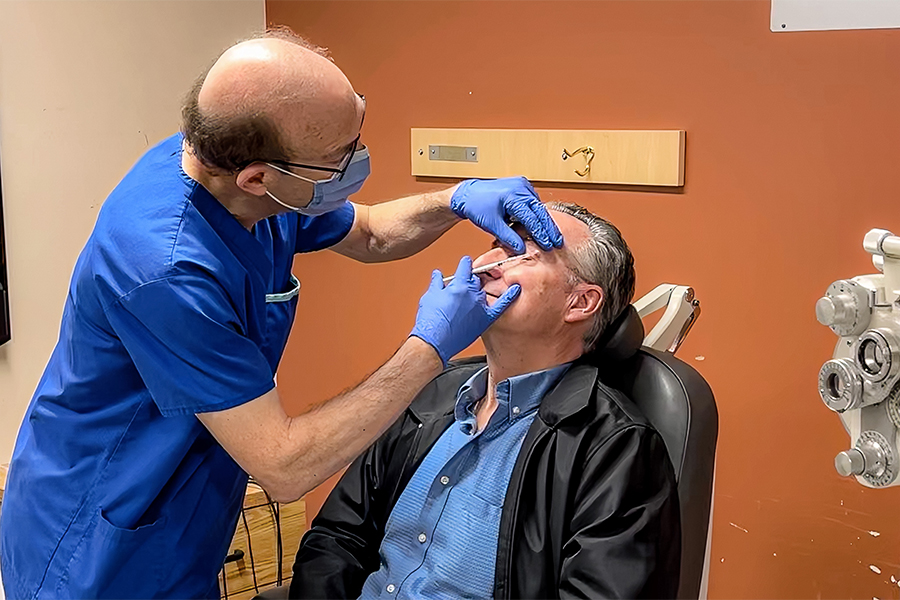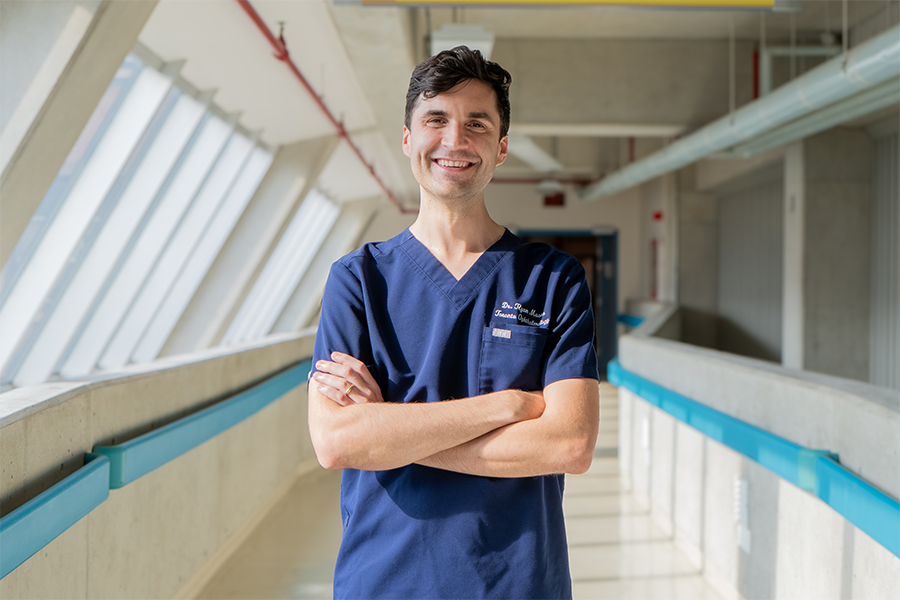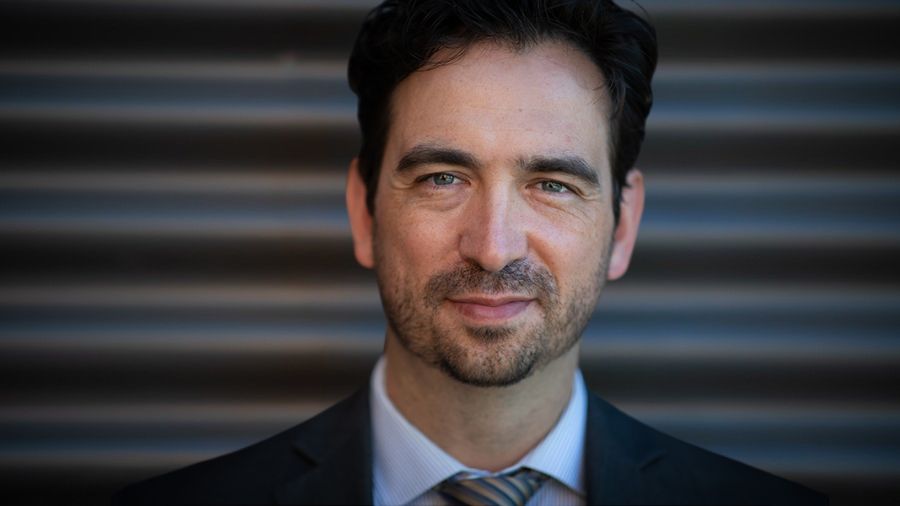
Originating in a lab in San Francisco in the 1970s, botulinum toxin — best known by its trade names Botox, Xeomin and Dysport — is well known for its cosmetic uses, being the most common cosmetic procedure performed worldwide. What many people do not know is that Botox was originally developed to treat ophthalmological and neurological conditions.
In 1985, Dr. Stephen Kraft, a staff ophthalmologist at UHN’s Donald K. Johnson Eye Institute, treated the first patient in Ontario using Botox — then called Oculinum — at Toronto General Hospital. Dr. Kraft recently sat down with UHN News to discuss the history of Botox, its medical uses, how it has evolved over the past 40 years and future research.
What is Botox and what conditions does it treat?
Botox is a purified form of a bacterial toxin called botulinum toxin, which disrupts communication between nerves and muscles. In the body, when a nerve signals a muscle to contract, it releases a chemical called acetylcholine. What Botox does is stop the release of the chemical, creating a nerve block, which will stop muscles from contracting.
Botox was originally developed only for one purpose: to straighten crossed eyes and lazy eyes. It was formulated to be injected into the eye muscles as an alternative to surgery. We used dosages in the billionths of a gram, which were still strong enough to change the muscle activity and straighten the eyes. Then it was found to be very helpful for various disorders involving overactive facial muscles, some confined to the eyes, some on the face and some involving the neck.
Today, there are at least 50 different medical uses of Botox and other botulinum toxin products, including treating chronic migraines, facial dystonia, excessive sweating and spastic disorders.
What was your early experience using Botox? How was it received by the medical community?
It was really just curiosity. In medical school, we learned about all sorts of toxins, from snakes, spiders and other sources, and here we have one of the most dangerous toxins being developed to treat medical problems. It was very much like when Alexander Fleming discovered penicillin. Who would’ve thought that a fungal contaminant he chanced upon would transform the way we treat infections?
At the time, I was part of a small group of ophthalmologists who were exploring ways to use botulinum toxin. You can imagine the concern of our research ethics boards! We had to show them data from our early studies, including the precise dosage levels and safety margins. Once we proved that the drug was safe and showed great results, we started receiving interest from the broader medical community. Colleagues in other specialties, including orthopedics, neurology, rehab medicine and oral surgery, imagined additional uses of the toxin and started their own studies.
It was a really rewarding experience, not just being part of the initial breakthrough, but also seeing the ripple effect of the knowledge we gained. The people I taught went on to teach others, and seeing the applications of Botox expand across so many disciplines has been incredible.

Are you surprised by the wide range of Botox uses? Did you expect this when you started using it?
No, I didn’t predict the expansive number of things it’s being used for now, but I suspected that it would have broader applications. Early on, my neurology colleagues and I knew that since Botox worked for muscles around the eyes, it could also treat muscles in spasm in other areas of the body. One of my closest collaborators in early studies of Botox for neurological applications was Dr. Anthony Lang — now neurologist and Senior Scientist at UHN’s Krembil Brain Institute — who was exploring the use of Botox to treat movement disorders. Some of my orthopedic surgeon friends also recognized that Botox had potential for muscular therapy. Thanks to these collaborations, I knew that it would probably be used for a range of neurological and muscular conditions affecting different parts of the body, but early on, nobody among my small cohort of investigators had any notion of the cosmetic boom that it would cause.
Take us back to the clinical trial days. What was it like being the first physician in Ontario to treat patients using Botox — then Oculinum?
It was kind of awesome because this was the first time that, as a medical practitioner, I had the opportunity to be involved in the early stages of developing a new therapy.
On January 12, 1985, I treated the first three patients using Oculinum at Toronto General Hospital. They were the only patients I booked that day because I wanted to talk to them, explain the treatment to their family members, and also tell them about possible side effects to look out for. The patients were quite excited, especially when they started seeing results within a few days after just one treatment session. They were really thankful.
Many of my patients had tried all the other therapies available at the time, so this treatment was really the last resort. Some of them had lived with the condition for decades — it had seriously disrupted their daily lives, and in many cases, their occupations. Knowing that I was able to help them to get their lives back was extremely satisfying.
How common is this treatment now? How many patients do you see in the clinic?
I see around 40 patients in my clinic at Toronto Western Hospital every month, and they are mostly patients with blepharospasm, hemifacial spasm and migraine. Because Botox wears off over time, most of my patients come in for another treatment session every three to four months. Even though strabismus was one of the original conditions treated with Botox, most patients now choose to have surgery instead, to avoid potentially going through multiple treatments.
In your opinion, what are the most exciting new medical applications for Botox?
In the last 10 to 20 years, Botox and its sister products have been used to treat numerous conditions, including spastic bladders, stomach spasms, Achilles tendon spasticity (a serious problem for wheelchair users), excessive sweating, and various ophthalmological and neurological conditions.
I recently read an exciting study about a new form of botulinum toxin that is said to last up to six months. If this new compound proves to be safe and effective, some patients will be able to come in for treatment twice a year, instead of every 10 to 12 weeks. Another idea that was researched some years ago was to combine Botox with a drug that inhibits nerve growth, to extend its effects. We don’t have such a product yet, but this is an interesting avenue for research.
May is Vision Health Month. In Canada, more than 5.5 million people are living with eye diseases, such as glaucoma, age-related macular degeneration and cataracts, and this number is expected to double over the next 20 years. The clinicians and researchers at UHN’s Donald K. Johnson Eye Institute are at the forefront of innovation in patient care and research, integrating clinical expertise with cutting-edge science to develop novel treatments for eye conditions. Read more on eye health, common eye diseases and current research.
By Sara Yuan

No one ever changed the world on their own but when the bright minds at UHN work together with donors we can redefine the world of health care together.


